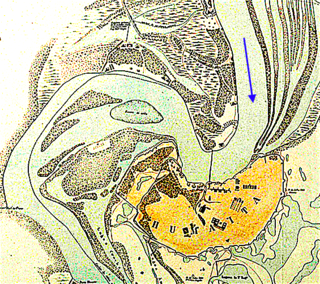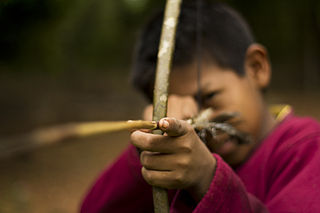
Guarani is a group of culturally-related indigenous peoples of South America. They are distinguished from the related Tupi by their use of the Guarani language. The traditional range of the Guarani people is in what is now Paraguay between the Paraná River and lower Paraguay River, the Misiones Province of Argentina, southern Brazil once as far east as Rio de Janeiro, and parts of Uruguay and Bolivia.

The Río de la Plata, also called the River Plate or La Plata River in English, is the estuary formed by the confluence of the Uruguay River and the Paraná River at Punta Gorda. It empties into the Atlantic Ocean and forms a funnel-shaped indentation on the southeastern coastline of South America. Depending on the geographer, the Río de la Plata may be considered a river, an estuary, a gulf, or a marginal sea. If considered a river, it is the widest in the world, with a maximum width of 220 kilometres (140 mi).

Rio Grande do Sul is a state in the southern region of Brazil. It is the fifth-most-populous state and the ninth largest by area. Located in the southernmost part of the country, Rio Grande do Sul is bordered clockwise by Santa Catarina to the north and northeast, the Atlantic Ocean to the east, the Uruguayan departments of Rocha, Treinta y Tres, Cerro Largo, Rivera and Artigas to the south and southwest, and the Argentine provinces of Corrientes and Misiones to the west and northwest. The capital and largest city is Porto Alegre. The state has the highest life expectancy in Brazil, and the crime rate is relatively low compared to the Brazilian national average. Despite the high standard of living, unemployment is still high in the state, as of 2017. The state has 5.4% of the Brazilian population and it is responsible for 6.6% of the Brazilian GDP.
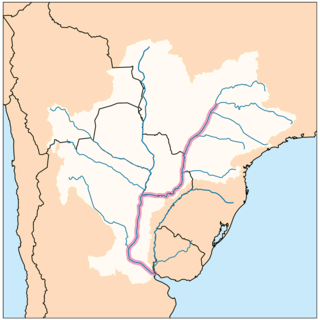
The Paraná River is a river in south-central South America, running through Brazil, Paraguay, and Argentina for some 4,880 kilometres (3,030 mi). Among South American rivers, it is second in length only to the Amazon River. It merges with the Paraguay River and then farther downstream with the Uruguay River to form the Río de la Plata and empties into the Atlantic Ocean.

The Paraguay expedition (1858–1859) was an American diplomatic mission and nineteen-ship squadron ordered by President James Buchanan to South America to demand redress for certain wrongs alleged to have been done by Paraguay, and seize its capital Asunción if it was refused. The expedition was sent without an adequate investigation of the facts; most modern scholars have considered Buchanan's complaints were probably unjustified. The real cause of the misunderstandings was that neither country had employed a competent diplomatic service. Buchanan may have had an ulterior motive, such as to distract public opinion from the domestic concerns that afflicted his presidency.
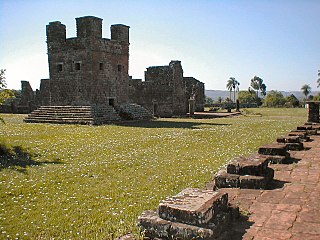
La Santísima Trinidad de Paraná, or the Most Holy Trinity of Paraná, is the name of a former Jesuit reduction in Paraguay. It is an example of one of the many Jesuit reductions, small colonies established by the missionaries in various locations in South America, such as Brazil, Argentina and Paraguay throughout the 17th and 18th century. These missions were built as self-contained societies that existed outside of regular Spanish colonial life that integrated indigenous populations with Christian faith.

The Treaty of the Triple Alliance was a treaty that allied the Empire of Brazil, Argentina, and Uruguay against Paraguay. Signed in 1865, after the outbreak of the Paraguayan War, its articles prescribed the allies' actions both during and after the war. The war led to the near-annihilation of Paraguay.

The Arc de Triomf is a triumphal arch in the city of Barcelona in Catalonia, Spain. It was built by architect Josep Vilaseca i Casanovas as the main access gate for the 1888 Barcelona World Fair. The arch crosses over the wide central promenade of the Passeig de Lluís Companys, leading to the Ciutadella Park that now occupies the site of the world fair. It is located at the northern end of the promenade, facing the Passeig de Sant Joan.

Thomas Joseph Hutchinson (1820–1885) was an Anglo-Irish explorer and writer. Born in January 1820 at Stonyford County Kilkenny, Ireland, he reportedly studied medicine in Germany. After a trip to West Africa in 1851, he became chief surgeon on the Niger expedition (1854–1855). After two years as English Consul at the Bight of Biafra and Fernando Po, he became governor of the latter place (1857) and in 1861 was transferred to the consulate at Rosario in Argentina, where he took part in the Salado expedition of 1862. In 1870 he was appointed Consul at Callao and three years later retired to his Irish home. He later travelled through Europe during the 1870s, and publisher several books. He died in Florence, Italy in March 1885.

Plaça d'Espanya is one of Barcelona's most important squares, built on the occasion of the 1929 Barcelona International Exposition, held at the foot of Montjuïc, in the Sants-Montjuïc district.

Luiz Carlos Sarolli, known as Caio Júnior or Caio Jr., was a Brazilian football forward and coach.

Cesáreo Bernaldo de Quirós was an Argentine painter of the post-impressionist school.

Doma menorquina is the traditional style of riding of the island of Menorca. It is closely associated with the Menorquín horse.

The Teatre Principal is the oldest theatre in Barcelona, founded in 1579, built between 1597 and 1603 and rebuilt several times, mainly in 1788 and again in 1848. The theatre was originally named the Teatro de la Santa Cruz in Spanish. It is located on the famous avenue of La Rambla.

The Paraguayan Athletics Federation is the governing body for the sport of athletics in Paraguay.

Michael George Mulhall (1836–1900) was an Irish author, statistician, economist and newspaper editor. He co-founded the Buenos Aires Standard, which in 1862 became the first English-language newspaper to be published daily in South America. He co-authored the first English-language book published in that continent, The Handbook of the River Plate, a work that went to six editions, was widely consulted by immigrants and is now a historical sourcebook. His Dictionary of Statistics became a standard work of reference.

Public art in Barcelona is a designated group of monuments and outdoor sculptures in the city. The artworks in city's architecture and network of museums, parks, and gardens, put an artistic stamp on the Catalan capital. Public art in the city developed in the 19th century, although the first municipal commission was the 1673 monument to Saint Eulalia in Pedró Square.
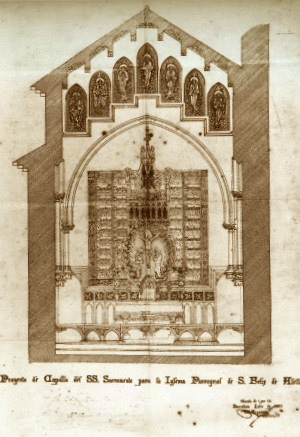
The Altarpiece of Alella is an altarpiece by the Catalan architect Antoni Gaudí that is part of the project of the chapel of the Holy Sacrament commissioned in 1883 by the Rector Jaume Puig i Claret for the parish church of Sant Feliu in Alella. It became known by a drawing preserved in the parochial archive found in 1959, delineated with India ink in two colours and showing Gaudí's signature, published for the first time in the same year. A reproduction was included the book Gaudí by George R. Collins the following year which was transcendent for the worldwide diffusion of the work of the architect of Reus as it was the first monograph dedicated to him in English language.


![Corrida de sortijas, oil on canvas by the Uruguayan painter Horacio Espondaburu [es] (1855-1902), now in the Museo Historico Nacional of Montevideo Horacio Espondaburu - Corrida de sortijas.jpg](http://upload.wikimedia.org/wikipedia/commons/thumb/a/a6/Horacio_Espondaburu_-_Corrida_de_sortijas.jpg/220px-Horacio_Espondaburu_-_Corrida_de_sortijas.jpg)















